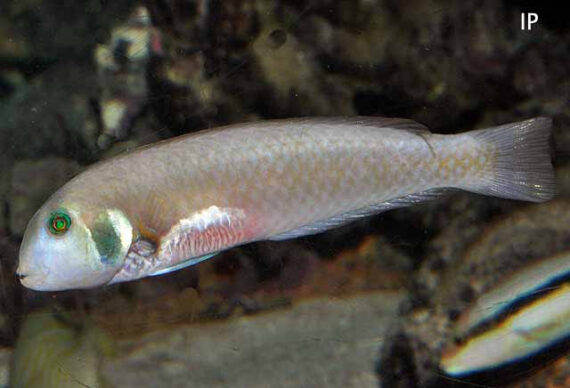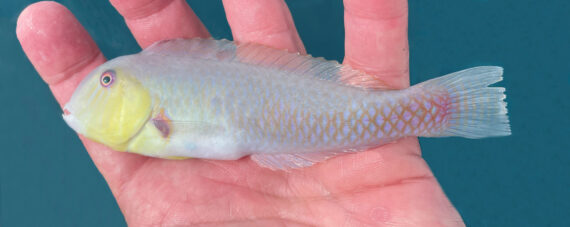Rosy Razorfish, Xyrichtys martinicensis
 Rosy Razorfish, Xyrichtys martinicensis, Initial Phase (IP) Female. Underwater photograph taken in the coastal waters of Curacao, February 2013. Photograph and identification courtesy of Dr. Ross Robertson, Smithsonian Institute, Panama City, Panama.
Rosy Razorfish, Xyrichtys martinicensis, Initial Phase (IP) Female. Underwater photograph taken in the coastal waters of Curacao, February 2013. Photograph and identification courtesy of Dr. Ross Robertson, Smithsonian Institute, Panama City, Panama.
 Rosy Razorfish, Xyrichtys martinicensis, Terminal Phase (TIP) Male. Fish caught from coastal waters off Broward County, Florida, June 2023. Length: 12.2 cm (5.0 inches). Catch, photograph and identification courtesy of Dominick Porcelli, Lighthouse Point, Florida.
Rosy Razorfish, Xyrichtys martinicensis, Terminal Phase (TIP) Male. Fish caught from coastal waters off Broward County, Florida, June 2023. Length: 12.2 cm (5.0 inches). Catch, photograph and identification courtesy of Dominick Porcelli, Lighthouse Point, Florida.
The Rosy Razorfish, Xyrichtys martinicensis, is a member of the Wrasse or Labridae Family, that is also known as the Straight-tail Razorfish and in Mexico as cuchillo llorón. Globally, there are twenty-seven species in the genus Xyrichtys, of which four are found in Mexican waters, three in the Atlantic and one in the Pacific Ocean. Their common name razorfish stems from their compressed bodies that have a sharp leading edge on their forehead and snout that allows quick entry into the sand.
The Rosy Razorfish has an oblong strongly compressed slender body with an elongated rounded head profile with a bluntly pointed snout with a fleshy longitudinal keel at the front. The juveniles are a silvery transparent color with a brown stripe that runs from the eye to the caudal fin base. The Initial Phase (IP) Females are greenish to tan dorsally transitioning to pink ventrally; they have a face with a white background with a dark brown blotch on the cheek that is bordered above and below by white areas, a diffuse orange stripe runs from the eye to the caudal fin base, a large white blotch on the belly and thin red bars, and a red caudal base. The Terminal Phase (TP) Males are greenish-blue in color with their heads having red eyes, and golden cheeks and gill covers that have narrow blue bars; they have a black bar on the pectoral fin base, their pelvic fins are yellow and their body scales have blue vertical lines. Their head has a protrusible mouth with thick lips and opens at the front and is equipped with a large pair of canine teeth at the front and eyes on the upper half. Their anal fin as 3 spines and 12 or 13 rays; their caudal fin in females is rounded and in males straight; their dorsal fin is continuous with 9 spines and 12 rays; and, their pelvic fins are pointed. They have 21 to 25 gill rakers. Their lateral line is broken into two sections.
The Rosy Razorfish are normally found half buried on the bottom within sand and seagrass beds at depths between 5 m (16 feet) and 40 m (139 feet). They reach a maximum of 15.0 cm (5.9 inches) in length. They feed on small sand-dwelling invertebrates. They are protogynous sequential hermaphroditism that undergo a sex-change from female to male that reproduce in harems of multiple females and one male. They have the ability to dive head first and submerge in the sand for protection. The Rosy Razorfish is poorly studied with very limited information available about their lifestyle and behavioral patterns including specific details on age, growth, longevity, movement patterns, diet, habitat use, and reproduction.
The Rosy Razorfish is a resident of all Mexican waters of the Atlantic Ocean including the Gulf of Mexico and the east coast of the Yucatán Peninsula in the Caribbean.
The Rosy Razorfish is similar to and can be confused with three other fish found in Mexican waters of the Atlantic: the Bluelip Parrotfish, Cryptotomus roseus (pointed snout), the Green Razorfish, Xyrichtys splendens (deep body), and the Pearly Razorfish, Xyrichtys novacula (steep head profile).
From a conservation perspective the Rosy Razorfish is currently considered to be of Least Concern with stable, widely distributed populations. They are too small and too rare to be of interest to most.